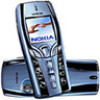Nokia 7250i Nokia 7250i User Guide in English - Page 172
Important safety information, recommendations of Wireless Technology Research. Persons
 |
View all Nokia 7250i manuals
Add to My Manuals
Save this manual to your list of manuals |
Page 172 highlights
Reference information All of the above suggestions apply equally to your phone, battery, charger or any enhancement. If any of them are not working properly, take them to your nearest qualified service facility. The personnel there will assist you, and if necessary, arrange for service. • IMPORTANT SAFETY INFORMATION Traffic Safety Do not use a handheld telephone while driving a vehicle. Always secure the phone in its holder; do not place the phone on the passenger seat or where it can break loose in a collision or sudden stop. Remember road safety always comes first! Operating environment Remember to follow any special regulations in force in any area and always switch off your phone whenever it is forbidden to use it, or when it may cause interference or danger. Use the phone only in its normal operating positions. Electronic devices Most modern electronic equipment is shielded from radio frequency (RF) signals. However, certain electronic equipment may not be shielded against the RF signals from your wireless phone. PACEMAKERS Pacemaker manufacturers recommend that a minimum separation of 6 inches (20 cm) be maintained between a handheld wireless phone and a pacemaker to avoid potential interference with the pacemaker. These recommendations are consistent with the independent research by and recommendations of Wireless Technology Research. Persons with pacemakers: • Should always keep the phone more than 6 inches (20 cm) from their pacemaker when the phone is switched on • Should not carry the phone in a breast pocket [ 161 ]















